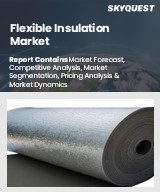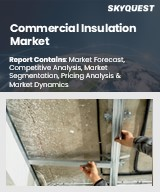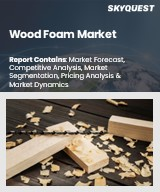
|
시장보고서
상품코드
1722738
방음 시장 보고서 : 재료 유형, 판매채널, 최종사용자, 지역별(2025-2033년)Acoustic Insulation Market Report by Material Type (Stone Wool, Glass Wool, Plastic Foam, and Others), Sales Channel (Offline, Online), End User (Building and Construction, Industrial, Transportation), and Region 2025-2033 |
||||||
세계 방음 시장 규모는 2024년 157억 달러에 달했습니다. 향후 시장은 2033년까지 234억 달러에 달할 것으로 예상되며, 2025-2033년 4.5%의 연평균 성장률(CAGR)을 보일 것으로 예측됩니다. 이 시장의 주요 원동력은 건설 분야에서의 제품 수요 증가와 자동차의 단열재 탑재 증가입니다. 또한, 엄격한 소음 규제 정책이 방음재 수요를 촉진하고 있습니다. 이는 방음에 대한 수요를 촉진하고 시장 성장에 기여하고 있습니다.
차음성은 음파를 반사하거나 흡수하여 음향적 쾌적성을 향상시키는 재료의 특성을 말합니다. 일반적으로 사용되는 방음 재료에는 아스팔트 시트, 섬유 벨트, 미네랄 울, 유리 섬유, 셀룰로오스, 스프레이 폼, 발포 보드 등이 있습니다. 이러한 재료는 흡음 및 방진 성능을 향상시켜 소음 공해를 최소화합니다. 차량 경적, 라디오, 스피커 등의 공기전파음, 덕트나 중공 코어 도어를 통해 전달되는 소리와 같은 측면음, 충격음을 감소시킬 수 있습니다. 그 결과, 차음재는 건설, 석유 및 가스, 에너지, 운송 등 다양한 산업 분야에서 널리 사용되고 있습니다.
방음 시장 동향 :
세계 건설 산업의 괄목할만한 성장은 시장 전망을 밝게 하는 중요한 요소 중 하나입니다. 음향 단열 솔루션은 외란을 최소화하고 내화 및 내열성을 높이기 위해 주거용, 상업용, 산업용 건물에 널리 사용되고 있습니다. 이러한 단열재는 녹음실, 오페라 홀, 연구소, 영화관 등 전문적인 공간에서 잔향을 줄이고 균형 잡힌 음향 환경을 유지하여 녹음 스튜디오, 오페라 홀, 연구실, 영화관 등 전문적인 공간에서 잔향을 줄입니다. 또한, 유리솜을 효과적으로 대체할 수 있는 에어로겔의 채택이 증가하고 있는 것도 시장 성장을 가속하고 있습니다. 에어로겔은 가볍고 내구성이 뛰어나며, 비용 효율적이고, 설치 및 재설치가 편리하며, 기존에 사용되던 재료보다 높은 단열성을 가지고 있습니다. 또한, 병동과 수술실의 방음에 방음 재료가 널리 채택되고 있는 것도 시장 성장을 가속하고 있습니다. 기타 요인으로는 엄격한 소음 공해 기준의 도입과 광범위한 조사 개발 활동 등이 시장 성장을 가속할 것으로 예측됩니다.
본 보고서에서 다룬 주요 질문
- 방음 시장 규모는?
- 방음 시장 전망은?
- 방음 시장을 주도하는 주요 요인은?
- 방음 시장에서 가장 큰 점유율을 차지하는 지역은?
- 세계 방음 시장의 주요 기업은?
목차
제1장 서문
제2장 조사 범위와 조사 방법
- 조사 목적
- 이해관계자
- 데이터 소스
- 1차 정보
- 2차 정보
- 시장 추정
- 보텀업 접근
- 톱다운 접근
- 조사 방법
제3장 주요 요약
제4장 서론
- 개요
- 주요 업계 동향
제5장 세계의 방음 시장
- 시장 개요
- 시장 실적
- COVID-19의 영향
- 시장 예측
제6장 시장 분석 : 재료 타입별
- 스톤울
- 글라스울
- 플라스틱 폼
- 기타
제7장 시장 분석 : 판매채널별
- 오프라인
- 온라인
제8장 시장 분석 : 최종사용자별
- 건축 및 건설
- 산업
- 운송
제9장 시장 분석 : 지역별
- 북미
- 미국
- 캐나다
- 아시아태평양
- 중국
- 일본
- 인도
- 한국
- 호주
- 인도네시아
- 기타
- 유럽
- 독일
- 프랑스
- 영국
- 이탈리아
- 스페인
- 러시아
- 기타
- 라틴아메리카
- 브라질
- 멕시코
- 기타
- 중동 및 아프리카
- 시장 내역 : 국가별
제10장 SWOT 분석
- 개요
- 강점
- 약점
- 기회
- 위협
제11장 밸류체인 분석
제12장 Porter의 Five Forces 분석
- 개요
- 바이어의 교섭력
- 공급 기업의 교섭력
- 경쟁 정도
- 신규 진출업체의 위협
- 대체품의 위협
제13장 가격 분석
제14장 경쟁 구도
- 시장 구조
- 주요 기업
- 주요 기업 개요
- 3M Company
- Armacell
- BASF SE
- Compagnie de Saint-Gobain S.A.
- Fletcher Insulation Pty Limited(Fletcher Building Limited)
- Johns Manville(Berkshire Hathaway Inc.)
- Kingspan Group plc
- Knauf Insulation
- Lanxess AG
- Owens Corning
- Recticel Insulation(Recticel Group)
- Rockwool International A/S
- Trelleborg AB
The global acoustic insulation market size reached USD 15.7 Billion in 2024. Looking forward, the market is expected to reach USD 23.4 Billion by 2033, exhibiting a growth rate (CAGR) of 4.5% during 2025-2033. The market is majorly driven by the rising product demand in the construction sector and increasing incorporation of insulation materials in vehicles. Moreover, stringent regulatory policies for noise control are chiefly fueling the demand for soundproofing materials. This, in turn, is facilitating the demand for acoustic insulation, thereby contributing to the market growth.
Acoustic insulation, or soundproofing insulation, refers to the property of a material to reflect or absorb the sound waves to achieve enhances acoustic comfort. Some of the commonly used acoustic insulation materials include bitumen sheets, fiber belts, mineral wool, fiberglass, blown-in cellulose, spray foam and foam board. These materials exhibit improved sound-absorbing and vibration dampening capabilities and aid in minimizing sound pollution. They can reduce airborne sounds, such as vehicle horns, radios and loudspeakers, flanking sounds, such as the sounds traveling through the ductwork and hollow core doors, and impact sounds. As a result, acoustic insulation materials are widely used across various industries, such as construction, oil and gas, energy and transportation.
Acoustic Insulation Market Trends:
Significant growth in the construction industry across the globe is one of the key factors creating a positive outlook for the market. Acoustic insulation solutions are widely used across residential, commercial and industrial buildings to minimize external disturbances and enhance fire and thermal resistance. These insulation materials reduce the reverberations and maintain a balanced acoustic environment in professional spaces, such as recording studios, opera halls, laboratories and movie theatres. Moreover, the increasing adoption of aerogel as an effective substitute for glass wool is providing a thrust to the market growth. Aerogel is lightweight, durable, cost-effective, convenient to install and reinstall and has a higher insulation value than the traditionally used materials. Additionally, the widespread adoption of acoustic insulation materials for soundproofing hospital wards and operation theaters is also favoring the market growth. Other factors, including the implementation of stringent noise pollution standards, along with extensive research and development (R&D) activities, are anticipated to drive the market toward growth.
Key Market Segmentation:
Breakup by Material Type:
- Stone Wool
- Glass Wool
- Plastic Foam
- Others
Breakup by Sales Channel:
- Offline
- Online
Breakup by End User:
- Building and Construction
- Industrial
- Transportation
Breakup by Region:
- North America
- United States
- Canada
- Asia-Pacific
- China
- Japan
- India
- South Korea
- Australia
- Indonesia
- Others
- Europe
- Germany
- France
- United Kingdom
- Italy
- Spain
- Russia
- Others
- Latin America
- Brazil
- Mexico
- Others
- Middle East and Africa
Competitive Landscape:
The competitive landscape of the industry has also been examined along with the profiles of the key players being 3M Company, Armacell, BASF SE, Compagnie de Saint-Gobain S.A., Fletcher Insulation Pty Limited (Fletcher Building Limited), Johns Manville (Berkshire Hathaway Inc.), Kingspan Group plc, Knauf Insulation, Lanxess AG, Owens Corning, Recticel Insulation (Recticel Group), Rockwool International A/S and Trelleborg AB.
Key Questions Answered in This Report
- 1.How big is the acoustic insulation market?
- 2.What is the future outlook of acoustic insulation market?
- 3.What are the key factors driving the acoustic insulation market?
- 4.Which region accounts for the largest acoustic insulation market share?
- 5.Which are the leading companies in the global acoustic insulation market?
Table of Contents
1 Preface
2 Scope and Methodology
- 2.1 Objectives of the Study
- 2.2 Stakeholders
- 2.3 Data Sources
- 2.3.1 Primary Sources
- 2.3.2 Secondary Sources
- 2.4 Market Estimation
- 2.4.1 Bottom-Up Approach
- 2.4.2 Top-Down Approach
- 2.5 Forecasting Methodology
3 Executive Summary
4 Introduction
- 4.1 Overview
- 4.2 Key Industry Trends
5 Global Acoustic Insulation Market
- 5.1 Market Overview
- 5.2 Market Performance
- 5.3 Impact of COVID-19
- 5.4 Market Forecast
6 Market Breakup by Material Type
- 6.1 Stone Wool
- 6.1.1 Market Trends
- 6.1.2 Market Forecast
- 6.2 Glass Wool
- 6.2.1 Market Trends
- 6.2.2 Market Forecast
- 6.3 Plastic Foam
- 6.3.1 Market Trends
- 6.3.2 Market Forecast
- 6.4 Others
- 6.4.1 Market Trends
- 6.4.2 Market Forecast
7 Market Breakup by Sales Channel
- 7.1 Offline
- 7.1.1 Market Trends
- 7.1.2 Market Forecast
- 7.2 Online
- 7.2.1 Market Trends
- 7.2.2 Market Forecast
8 Market Breakup by End User
- 8.1 Building and Construction
- 8.1.1 Market Trends
- 8.1.2 Market Forecast
- 8.2 Industrial
- 8.2.1 Market Trends
- 8.2.2 Market Forecast
- 8.3 Transportation
- 8.3.1 Market Trends
- 8.3.2 Market Forecast
9 Market Breakup by Region
- 9.1 North America
- 9.1.1 United States
- 9.1.1.1 Market Trends
- 9.1.1.2 Market Forecast
- 9.1.2 Canada
- 9.1.2.1 Market Trends
- 9.1.2.2 Market Forecast
- 9.1.1 United States
- 9.2 Asia-Pacific
- 9.2.1 China
- 9.2.1.1 Market Trends
- 9.2.1.2 Market Forecast
- 9.2.2 Japan
- 9.2.2.1 Market Trends
- 9.2.2.2 Market Forecast
- 9.2.3 India
- 9.2.3.1 Market Trends
- 9.2.3.2 Market Forecast
- 9.2.4 South Korea
- 9.2.4.1 Market Trends
- 9.2.4.2 Market Forecast
- 9.2.5 Australia
- 9.2.5.1 Market Trends
- 9.2.5.2 Market Forecast
- 9.2.6 Indonesia
- 9.2.6.1 Market Trends
- 9.2.6.2 Market Forecast
- 9.2.7 Others
- 9.2.7.1 Market Trends
- 9.2.7.2 Market Forecast
- 9.2.1 China
- 9.3 Europe
- 9.3.1 Germany
- 9.3.1.1 Market Trends
- 9.3.1.2 Market Forecast
- 9.3.2 France
- 9.3.2.1 Market Trends
- 9.3.2.2 Market Forecast
- 9.3.3 United Kingdom
- 9.3.3.1 Market Trends
- 9.3.3.2 Market Forecast
- 9.3.4 Italy
- 9.3.4.1 Market Trends
- 9.3.4.2 Market Forecast
- 9.3.5 Spain
- 9.3.5.1 Market Trends
- 9.3.5.2 Market Forecast
- 9.3.6 Russia
- 9.3.6.1 Market Trends
- 9.3.6.2 Market Forecast
- 9.3.7 Others
- 9.3.7.1 Market Trends
- 9.3.7.2 Market Forecast
- 9.3.1 Germany
- 9.4 Latin America
- 9.4.1 Brazil
- 9.4.1.1 Market Trends
- 9.4.1.2 Market Forecast
- 9.4.2 Mexico
- 9.4.2.1 Market Trends
- 9.4.2.2 Market Forecast
- 9.4.3 Others
- 9.4.3.1 Market Trends
- 9.4.3.2 Market Forecast
- 9.4.1 Brazil
- 9.5 Middle East and Africa
- 9.5.1 Market Trends
- 9.5.2 Market Breakup by Country
- 9.5.3 Market Forecast
10 SWOT Analysis
- 10.1 Overview
- 10.2 Strengths
- 10.3 Weaknesses
- 10.4 Opportunities
- 10.5 Threats
11 Value Chain Analysis
12 Porters Five Forces Analysis
- 12.1 Overview
- 12.2 Bargaining Power of Buyers
- 12.3 Bargaining Power of Suppliers
- 12.4 Degree of Competition
- 12.5 Threat of New Entrants
- 12.6 Threat of Substitutes
13 Price Analysis
14 Competitive Landscape
- 14.1 Market Structure
- 14.2 Key Players
- 14.3 Profiles of Key Players
- 14.3.1 3M Company
- 14.3.1.1 Company Overview
- 14.3.1.2 Product Portfolio
- 14.3.1.3 Financials
- 14.3.2 Armacell
- 14.3.2.1 Company Overview
- 14.3.2.2 Product Portfolio
- 14.3.3 BASF SE
- 14.3.3.1 Company Overview
- 14.3.3.2 Product Portfolio
- 14.3.3.3 Financials
- 14.3.3.4 SWOT Analysis
- 14.3.4 Compagnie de Saint-Gobain S.A.
- 14.3.4.1 Company Overview
- 14.3.4.2 Product Portfolio
- 14.3.4.3 Financials
- 14.3.4.4 SWOT Analysis
- 14.3.5 Fletcher Insulation Pty Limited (Fletcher Building Limited)
- 14.3.5.1 Company Overview
- 14.3.5.2 Product Portfolio
- 14.3.6 Johns Manville (Berkshire Hathaway Inc.)
- 14.3.6.1 Company Overview
- 14.3.6.2 Product Portfolio
- 14.3.7 Kingspan Group plc
- 14.3.7.1 Company Overview
- 14.3.7.2 Product Portfolio
- 14.3.7.3 Financials
- 14.3.7.4 SWOT Analysis
- 14.3.8 Knauf Insulation
- 14.3.8.1 Company Overview
- 14.3.8.2 Product Portfolio
- 14.3.9 Lanxess AG
- 14.3.9.1 Company Overview
- 14.3.9.2 Product Portfolio
- 14.3.9.3 Financials
- 14.3.9.4 SWOT Analysis
- 14.3.10 Owens Corning
- 14.3.10.1 Company Overview
- 14.3.10.2 Product Portfolio
- 14.3.10.3 Financials
- 14.3.10.4 SWOT Analysis
- 14.3.11 Recticel Insulation (Recticel Group)
- 14.3.11.1 Company Overview
- 14.3.11.2 Product Portfolio
- 14.3.12 Rockwool International A/S
- 14.3.12.1 Company Overview
- 14.3.12.2 Product Portfolio
- 14.3.12.3 Financials
- 14.3.13 Trelleborg AB
- 14.3.13.1 Company Overview
- 14.3.13.2 Product Portfolio
- 14.3.13.3 Financials
- 14.3.1 3M Company



















